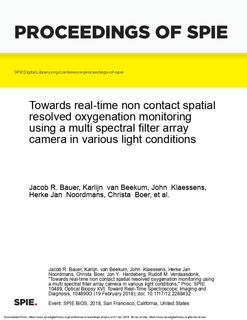| dc.contributor.author | Bauer, Jacob Renzo | |
| dc.contributor.author | van Beekum, Karlijn | |
| dc.contributor.author | Klaessens, John | |
| dc.contributor.author | Noordmans, Herke Jan | |
| dc.contributor.author | Boer, Christa | |
| dc.contributor.author | Hardeberg, Jon Yngve | |
| dc.contributor.author | Verdaasdonk, Rudolf | |
| dc.date.accessioned | 2019-04-01T07:55:57Z | |
| dc.date.available | 2019-04-01T07:55:57Z | |
| dc.date.created | 2018-06-28T13:42:37Z | |
| dc.date.issued | 2018 | |
| dc.identifier.citation | Proceedings of SPIE, the International Society for Optical Engineering. 2018, 10489 . | nb_NO |
| dc.identifier.issn | 0277-786X | |
| dc.identifier.uri | http://hdl.handle.net/11250/2592605 | |
| dc.description.abstract | Non contact spatial resolved oxygenation measurements remain an open challenge in the biomedical field and non contact patient monitoring. Although point measurements are the clinical standard till this day, regional differences in the oxygenation will improve the quality and safety of care. Recent developments in spectral imaging resulted in spectral filter array cameras (SFA). These provide the means to acquire spatial spectral videos in real-time and allow a spatial approach to spectroscopy. In this study, the performance of a 25 channel near infrared SFA camera was studied to obtain spatial oxygenation maps of hands during an occlusion of the left upper arm in 7 healthy volunteers. For comparison a clinical oxygenation monitoring system, INVOS, was used as a reference. In case of the NIRS SFA camera, oxygenation curves were derived from 2-3 wavelength bands with a custom made fast analysis software using a basic algorithm. Dynamic oxygenation changes were determined with the NIR SFA camera and INVOS system at different regional locations of the occluded versus non-occluded hands and showed to be in good agreement. To increase the signal to noise ratio, algorithm and image acquisition were optimised. The measurement were robust to different illumination conditions with NIR light sources. This study shows that imaging of relative oxygenation changes over larger body areas is potentially possible in real time. | nb_NO |
| dc.language.iso | eng | nb_NO |
| dc.publisher | Society of Photo-optical Instrumentation Engineers (SPIE) | nb_NO |
| dc.title | Towards real-time non contact spatial resolved oxygenation monitoring using a multi spectral filter array camera in various light conditions | nb_NO |
| dc.type | Journal article | nb_NO |
| dc.type | Peer reviewed | nb_NO |
| dc.description.version | publishedVersion | nb_NO |
| dc.source.pagenumber | 9 | nb_NO |
| dc.source.volume | 10489 | nb_NO |
| dc.source.journal | Proceedings of SPIE, the International Society for Optical Engineering | nb_NO |
| dc.identifier.doi | 10.1117/12.2288432 | |
| dc.identifier.cristin | 1594500 | |
| dc.relation.project | Norges forskningsråd: 247689 | nb_NO |
| dc.description.localcode | © 2018 Society of Photo Optical Instrumentation Engineers. One print or electronic copy may be made for personal use only. Systematic reproduction and distribution, duplication of any material in this paper for a fee or for commercial purposes, or modification of the content of the paper are prohibited. | nb_NO |
| cristin.unitcode | 194,63,10,0 | |
| cristin.unitname | Institutt for datateknologi og informatikk | |
| cristin.ispublished | true | |
| cristin.fulltext | postprint | |
| cristin.qualitycode | 1 | |
